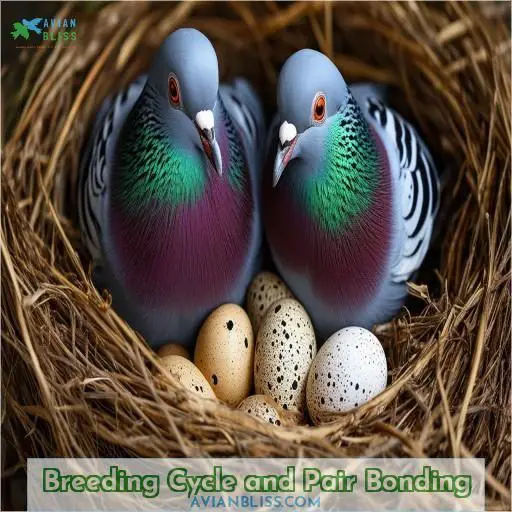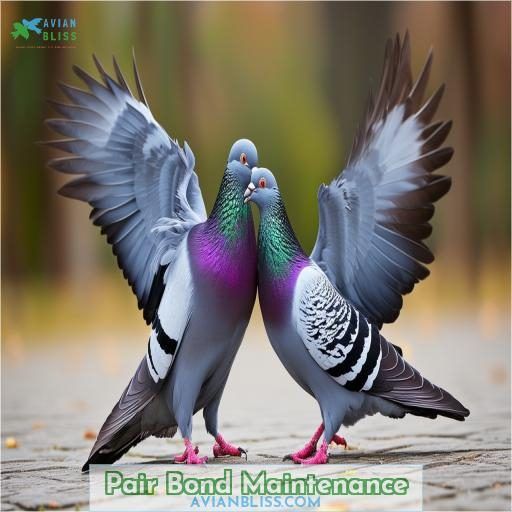This site is supported by our readers. We may earn a commission, at no cost to you, if you purchase through links.

Their courtship rituals involve elaborate displays like cooing, head bobbing, and circling. Once paired, both mates share nest-building duties and incubate the eggs together.
This lifelong commitment is maintained through behaviors like allopreening and vocal communication. While social monogamy allows occasional infidelity, pigeons exhibit remarkable mate fidelity and selective pressures favoring genetic diversity.
Their enduring companionship offers insights into the evolution of monogamous relationships in nature, and you’ll discover more about these devoted bonds as we explore further.
Table Of Contents
Key Takeaways
- Pigeons don’t just mate for life, they engage in elaborate courtship rituals, like cooing, head bobbing, and circling. It’s like they’re taking part in an avian dance-off to woo their potential partner!
- Once paired up, pigeons are the ultimate co-parents. They work together to build the nest, with the male gathering the materials and the female shaping the nest bowl. It’s a true team effort!
- While pigeons are famously monogamous, they’re not strictly sexually exclusive. Their "social monogamy" allows for a little bit of infidelity on the side, ensuring genetic diversity. It’s like they’ve found the perfect balance between commitment and keeping things spicy!
- Even though they mate for life, if a pigeon loses their partner, they won’t remain alone forever. They’ll often find a new mate, proving that even in the bird world, there’s always a chance for a fresh start and a new love story to unfold.
Do Pigeons Mate for Life?
Yes, pigeons typically mate for life. These birds form strong monogamous bonds with their partners, remaining together throughout their lives and raising multiple broods with the same mate.
Pigeons and Pair Bonding
Pigeons form lifelong monogamous bonds with their mates, a remarkable feat in the avian world. These long-lasting relationships encompass various aspects of their lives, from courtship rituals and nest-building to co-parenting offspring throughout multiple breeding seasons.
Monogamous Relationships
Pigeons are famously monogamous, forming strong pair bonds that can last for multiple breeding seasons. You’ll often see them engaging in frequent pair copulations and other bonding behaviors. While the pair bonding duration varies, it’s not uncommon for pigeons to remain paired for an extra year or more after their initial bond.
Lifelong Bonds
While pigeons form strong pair bonds, their lifelong bonds are influenced by genetic and environmental factors. In captivity, pigeons often mate for life due to their cognitive abilities and limited mate choices. However, in the wild, mate loss or cultural variations can lead to serial monogamy, where birds form new bonds after a partner’s death or separation.
Factors Affecting Pair Bonding
While pigeons typically form monogamous pair bonds for life, these bonds can be disrupted by the loss of a mate. In cases of mate loss, pigeons may exhibit "socially monogamous" behavior by finding a new partner, demonstrating the flexibility in their mating strategies.
Mate Loss
Though pigeons mate for life, you may be surprised to learn that if one partner dies or disappears, the surviving bird will often find a new mate. This "divorce" allows them to:
- Continue their breeding cycle
- Find a more compatible partner
- Introduce new genetic diversity
Mate loss, while unfortunate, highlights pigeons’ incredible mate fidelity and selective pressure for successful reproduction.
Social Monogamy
While pigeons form strong pair bonds, they’re not strictly sexually exclusive. Their "social monogamy" allows for occasional infidelity, influenced by factors like mate preferences and environmental cues. This aligns with their evolutionary drive for genetic diversity while still enjoying the benefits of monogamous pair bonding within their social context.
Breeding Cycle and Pair Bonding
Pigeons engage in an elaborate courtship ritual before mating, involving coo vocalizations, head bobbing, and circling one another. Once a pair bond is established, they work together to build a nest, with the male gathering nesting materials and the female shaping the nest bowl where she’ll lay her eggs.
Courtship Behavior
After pairing up, pigeons exhibit fascinating courtship rituals to reinforce their bond. These include:
- Vocal coos and head bobbing displays
- Mutual preening and billing
- Territorial defense against rival males
Courtship plays a vital role in mate selection and ensuring successful breeding. Some pigeons even engage in extra-pair copulations, though monogamy remains the norm.
Nest Building
After courtship, you’ll witness pigeons gathering twigs, straw, and other materials to construct their nests. They carefully choose elevated, secluded nesting sites, like window ledges or rafters. The nest size accommodates their bulky bodies and future squabs. Notably, pigeons fortify nests with deterrents like thorns to ward off predators.
Egg Laying and Incubation
After courtship and nest building, both parents take turns incubating the eggs for around 18 days. The female typically lays two white eggs, with the second egg laid 1-3 days after the first. During incubation, the pair shares duties, with one bird incubating while the other forages for food.
Factors Influencing Mate Choice
When selecting a mate, pigeons consider physical appearance and behavior. The vibrant iridescent feathers, posture, and behavioral displays during courtship all factor into a pigeon’s mate choice.
Physical Appearance
When selecting mates, pigeons assess physical traits like feather color, beak size, plumage patterns, eye color, and body shape. These characteristics may signal health, genetic fitness, and compatibility. Vibrant feathers or symmetrical markings make potential partners more attractive. Though appearance matters, behavior plays a role too in this intricate courtship dance.
Behavior
You’re drawn to behavioral cues signaling pair preferences: precise courting displays, nest-building expertise, and attentive parenting prowess. But you may encounter:
- Mate desertion risks
- Low "divorce" rates
- Rare extra-pair copulations
Monogamy evolution favors faithful partners adept at caregiving – a window into monogamous bonds.
Pair Bond Maintenance
You’ll find that pigeons engage in allopreening, a social grooming behavior that helps maintain their pair bond. They also utilize vocalizations and spatial proximity to strengthen their bond; pairs often coo to one another and remain in close physical proximity. These behaviors reinforce the monogamous relationship between mated pigeons.
Allopreening
Allopreening, or mutual grooming, strengthens your pair bond. It’s an intimate ritual, rooted in evolutionary origins, that offers health benefits and hormonal regulation. Observe the intricate social hierarchy and neural mechanisms at play:
| Behavior | Significance |
|---|---|
| Gentle Nibbling | Trust, Comfort |
| Feather Rearranging | Bonding, Hygiene |
| Head Cocking | Attentiveness |
| Cooing | Affection |
| Proximity | Intimacy |
Vocalizations
You’ll hear pigeons frequently vocalize to maintain their pair bond. Their vocal repertoire includes:
- Cooing and murmuring at varying intensities to communicate and reinforce their connection
- Distinctive vocal dialects learned from their mate, signaling pair identity
- A wide vocal range spanning soft coos to boisterous calls
Vocalizations facilitate coordination, reinforce recognition, and strengthen the monogamous bond between partners.
Spatial Proximity
Pigeons maintain close physical proximity, reflecting their strong pair bonds. In urban environments, flocking behavior and foraging strategies often involve spatial patterns where mated pairs remain side-by-side. This spatial proximity reinforces their lifelong commitment, facilitating habitat selection and breeding success through shared vigilance and resource utilization.
Frequently Asked Questions (FAQs)
Do pigeons experience jealousy in their pair bonds?
Pigeons are known for their strong pair bonds. When their mate interacts with another pigeon, jealous behavior like aggressive cooing and wing-flapping often ensues.
How long do pigeon pairs remain bonded?
Like a devoted couple walking hand-in-hand, pigeon pairs often remain bonded for life, an unwavering connection forged through shared experiences and an innate drive to nurture their lineage.
Can pigeons have multiple mates simultaneously?
No, pigeons generally don’t have multiple mates simultaneously. They form long-term, monogamous pairs and cooperate in raising their young. However, in rare cases, pigeons may "divorce" and find new mates if their initial partner is unproductive or absent.
Do pigeons grieve the loss of a mate?
While grief is complex in animals, pigeons do mourn lost mates—cooing mournfully and refusing food. Their mate bonds are strong, so losing a partner deeply impacts them.
Do pigeons recognize their offspring after fledging?
Yes, pigeons recognize their offspring even after they leave the nest. They use vocalizations and visual cues to identify each other, maintaining a strong family bond.
Conclusion
Observe a pigeon pair grooming one another affectionately, and you witness the remarkable mate fidelity that defines their monogamous bonds.
These birds form enduring companionships through elaborate courtship rituals, careful co-parenting, and sustained pair-bonding behaviors like allopreening.
The way pigeons mate for life offers profound insights into the evolution of long-term partnerships across species, making their devoted unions a compelling subject for further study.








